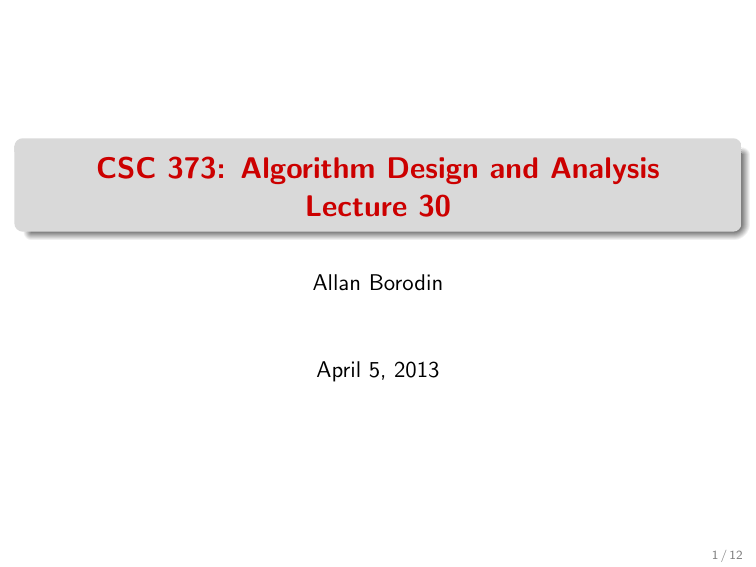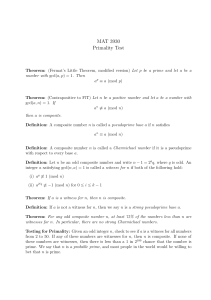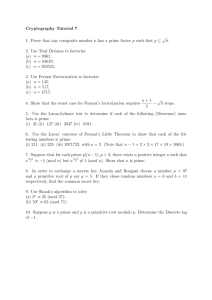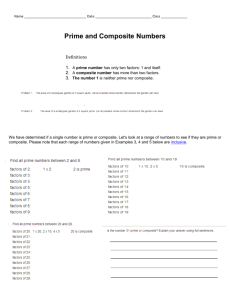CSC 373: Algorithm Design and Analysis Lecture 30 Allan Borodin April 5, 2013
advertisement

CSC 373: Algorithm Design and Analysis
Lecture 30
Allan Borodin
April 5, 2013
1 / 12
Announcements and Outline
Announcements
Two misstated questions on term test
Grading scheme for term test 3:
1
2
3
Test will be graded out of 25 with a max of 30 (i.e. up to 20% bonus
possible where now everyone has a better chance of getting bonus
marks)
Full credit (10 points) for seeing that Q1 was trivial; two points for
saying “false” because of clauses containing x ∨ x̄
Can obtain full credit for interpreting question in terms of
approximation ratio.
Today’s outline
Comments on the nature of the final exam
Review and finish discussion of RWALK algorithm for 2SAT
Brief discussion of 1-sided randomized compositeness algorithm
2 / 12
Papadimitriou’s random walk algorithm for 2-SAT
It is not difficult to show that 2-SAT (determining if a 2CNF formula
is satisfiable) is efficiently computable (reducible to directed ST
connectivity) whereas we know that 3-SAT is NP complete.
We will provide a conceptually simple 1-sided randomized algorithm
(RWALK) running in time O(n2 ) to show that 2-SAT is
computationally easy.
The same basic approach can be used to derive a randomized
algorithm (which in turn has led to a deterministic variant of the
idea) for 3SAT that runs in time (1.324)n . It is a big open question if
one can get time 2o(n) algorithm for 3-SAT.
This random walk idea is the basis for a widely used class of
algorithms known as Walk-Sat algorithms for SAT problems.
3 / 12
Random walk algorithm for 2-SAT
RWALK algorithm for 2CNF formula F
Choose a random or arbitrary truth assignment τ
For i = 1, 2, . . . , (c · n2 )
% with a sufficiently large c to obtain any desired probability of success
If τ satisfies F then
Report success and quit
Else
Let C be an unsatisfied clause and choose one of its literals `i at random
Flip the truth value of the literal `i to change τ
End If
End For
Claim
If f is satisfiable, then with say probability at least
succeed in finding a satisfying truth assignment.
1
2
the RWALK algorithm will
We can either increase c or run RWALK many times to increase the probability
of success.
4 / 12
Why RWALK works
Claim
Let τ ∗ be a truth assignment satisfying an n variable 2CNF F . Then we can view
RWALK as a random walk on a line graph (with nodes 1, 2, . . . , n) that is trying
to reach node n where node i indicates that τ matches τ ∗ in i coordinates.
Since the clause C was not satisfied, at least one of its literals must be set
different than τ ∗ . (It could be that both literals are different.)
This means that the probability (in terms of the walk on the line) of getting
closer to node n is at least 12 .
It can happen that as we are randomly walking, we may come across
another satisfying assignment but that will only shorten the time needed.
What remains to be shown is that a random walk on the line with
probability 12 to move left or right will hit every point on the line in
expected time 2n2 .
More generally, a uniform random walk (starting at any node) on a
connected graph G = (V , E ) will hit all nodes in expected time
2|E |(|V | − 1).
5 / 12
Randomized Compositeness/Primality Algorithm
One of the most influential randomized algorithms is a polynomial time
method for determining if a number is prime/composite.
Quick modern history of primality testing
Independently Solovay and Strassen, and Rabin (1974) gave two
different polynomial time 1-sided error algorithms for determining if
an n digit number x is prime.
The algorithm always outputs PRIME if x is prime and outputs
COMPOSITE with probability (say) 12 if x is composite.
That is, the algorithm could error (saying PRIME when x is
composite) with probability at most 12 .
I
I
This error probability can be reduced by repeated indpendent trials of
the algorithm.
That is, t trials would then yield an error probability at most 21t .
6 / 12
History continued
The Rabin algorithm is related to deterministic polynomial time
algorithm by G. Miller (1976) whose correctness requires the
Extended Riemann Hypothesis (ERH), a famous well-believed
conjecture in number theory.
Goldwasser and Kilian (1986) gave a polynomial time 0-sided error
algorithm.
Agarwal, Kayal and Saxena (2002) gave a deterministic polynomial
time algorithm.
7 / 12
So why concern oursleves with randomized
algorithms when the problem is solved?
There are polynomials and there are polynomials
The deterministic (or 0-sided algorithms) are not nearly as practical
as the 1-sided algorithms
These algorithms are an essential ingrediant in much of modern
cryptography where random primes are often needed.
Note that while primality testing is theoretically (i.e. in P) and
practically solvable, factoring is believed to be NP hard and even hard
in some sense of “average case complexity”.
Complexity based cryptography also depends on the hardness of
problems such as factoring integers.
8 / 12
Some basic group theory and number theory
ZN∗ = {a ∈ ZN | gcd(a, N) = 1} is a commutative group under
multiplication (mod N)
Lagrange Theorem If H is a subgroup of G then order (H) divides
order (G ).
Fermat’s Little Theorem: If N is prime then for a 6= 0 (mod N),
aN−1 = 1 (mod N)
Furthermore, if N is prime, then ZN∗ is a cyclic group; that is,
∃g : {g , g 2 , . . . , g N−1 } = ZN . This implies that for such a generator
g , g i 6= 1 for 1 ≤ i < N − 1
If N is prime, then ±1 mod N are precisely two distinct square roots
of 1.
The Chinese Remainder Theorem: If N1 and N2 are relatively
prime, then for all v1 , v2 , there exists a unique non-negative
w < N1 · N2 such that w = v1 (mod N1 ) and w = v2 (mod N2 )
9 / 12
A simple but not quite correct algorithm
We need two computational facts:
1
2
ai (mod N) can be efficiently computed by “repeated squaring mod
N”.
gcd(a, b) can be efficiently computed by the Euclidean algorithm.
Simple randomized primality algorithm that “almost works”
Choose a ∈ ZN \ {0} uniformly at random
If gcd(a, N) 6= 1 or aN−1 (mod N) 6= 1, then output “COMPOSITE”
Otherwise output “PRIME”.
10 / 12
When the simple algorithm does (and doesn’t) work
S = {a ∈ ZN∗ | aN−1 = 1 (mod N)} is a subgroup of ZN∗
Hence either S = ZN∗ if S is a proper subgroup, or by the Lagrange
Theorem, |S| ≤
|ZN∗ |
2
=
N−1
2
if S is not proper.
Hence if the simple algorithm finds an a where gcd(a, N) = 1 but
aN−1 6= 1 (mod N), then S is proper and therefore at least 21 half of
the elements in ZN \ {0} will be certificates showing N is not prime.
Hence the only numbers N that can defeat the simple algorithm are
the Carmichael numbers (also called false primes); i.e. those N for
which aN−1 = 1 (mod N) for all a ∈ ZN∗ .
It was only relatively recently (1994) when it was proven that there
are infinitely many Carmichael numbers.
I
I
The first three Carmichael numbers are 561, 1105, 1729.
There are only 255 Carmichael numbers ≤ 100,00,000.
11 / 12
Miller-Rabin 1-sided randomized algorithm
The Miller-Rabin algorithm
If gcd(a, N) 6= 1 then report composite and terminate
% This test isn’t really needed but we add it for clarity
Compute t, u such that N − 1 = (2t u), u odd and t ≥ 1.
x0 := 2u
% all computations are mod N
Randomly choose a ∈ ZN \ {0}
For i = 1, . . . , t
2
xi := xi−1
If xi = 1 and xi−1 ∈
/ {−1, 1} then report composite and terminate
End For
If xt 6= 1 then report composite and terminate
Else report prime
Claim: P[algorithm reports prime | N is composite] ≤ 12
Proof relies on fact that N is Carmichael implies N = N1 · N2 with
gcd(N1 , N2 ) = 1
12 / 12







